Leeds Metropolitan University
- 格式:pdf
- 大小:89.96 KB
- 文档页数:6
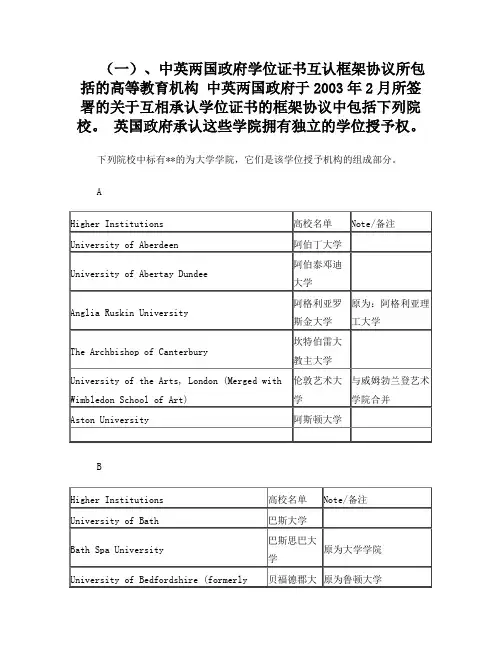
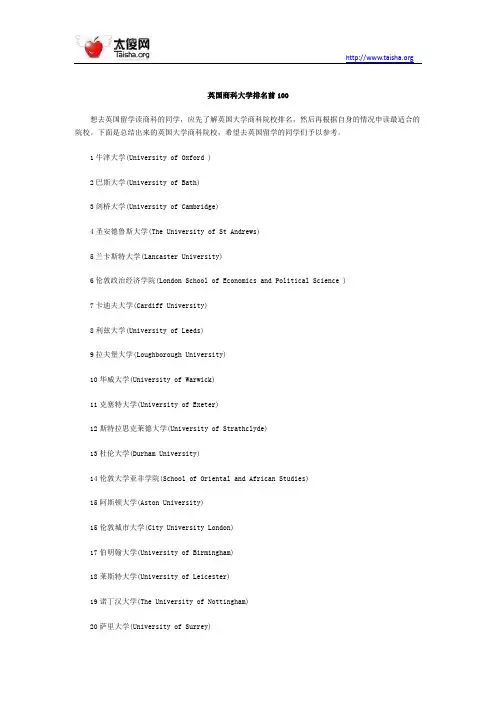
英国商科大学排名前100想去英国留学读商科的同学,应先了解英国大学商科院校排名,然后再根据自身的情况申读最适合的院校。
下面是总结出来的英国大学商科院校,希望去英国留学的同学们予以参考。
1牛津大学(University of Oxford )2巴斯大学(University of Bath)3剑桥大学(University of Cambridge)4圣安德鲁斯大学(The University of St Andrews)5兰卡斯特大学(Lancaster University)6伦敦政治经济学院(London School of Economics and Political Science )7卡迪夫大学(Cardiff University)8利兹大学(University of Leeds)9拉夫堡大学(Loughborough University)10华威大学(University of Warwick)11克塞特大学(University of Exeter)12斯特拉思克莱德大学(University of Strathclyde)13杜伦大学(Durham University)14伦敦大学亚非学院(School of Oriental and African Studies)15阿斯顿大学(Aston University)15伦敦城市大学(City University London)17伯明翰大学(University of Birmingham)18莱斯特大学(University of Leicester)19诺丁汉大学(The University of Nottingham)20萨里大学(University of Surrey)20约克大学(The University of York)22伦敦大学学院(University College London)22曼彻斯特大学(The University of Manchester)24纽卡斯尔大学(Newcastle University)25罗伯特戈登大学(The Robert Gordon University)26赫瑞瓦特大学(Heriot-Watt University )27南安普顿大学(University of Southampton)28阿伯丁大学(University of Aberdeen)29伦敦大学国王学院(King's College London)29肯特大学(University of Kent)31苏塞克斯大学(University of Sussex)32爱丁堡大学(The University of Edinburgh)33东英格利亚大学(University of East Anglia)33谢菲尔德大学(The University of Sheffield)35格拉斯哥大学(University of Glasgow)36皇家霍洛威大学(Royal Holloway, University of London) 37雷丁大学(University of Reading )38利物浦大学(University of Liverpool)39布鲁内尔大学(Brunel University)40巴斯泉大学(Bath Spa University)41布里斯托大学(University of Bristol)42考文垂大学(Coventry University)42基尔大学(Keele University)42白金汉大学(University of Buckingham)45波恩茅斯大学(Bournemouth University)45布拉德福德大学(University of Bradford)45朴茨茅斯大学(University of Portsmouth)45斯特林大学(University of Stirling)49龙比亚大学(Edinburgh Napier University)49贝尔法斯特女王大学(Queen’s University Belfast)51德蒙特福德大学(De Montfort University)52埃塞克斯大学(University of Essex)53诺丁汉特伦特大学(Nottingham Trent University)54哈德斯菲尔德大学(University of Huddersfield)55威尔士班戈大学(Bangor University)56诺森比亚大学(Northumbria University)56斯旺西大学(Swansea University)58西英格兰大学(University of the West of England)59谢菲尔德哈勒姆大学(Sheffield Hallam University)60曼彻斯特城市大学(Manchester Metropolitan University) 61布莱顿大学(University of Brighton)62伯明翰城市大学(Birmingham City University)62赫尔大学(The University of Hull)64阿伯里斯特维斯大学(Aberystwyth University)65林肯大学(University of Lincoln)66中央兰开夏大学(University of Central Lancashire)66北安普顿大学(The University of Northampton)66阿尔斯特大学(University of Ulster)69牛津布鲁克斯大学(Oxford Brookes University)70伦敦大学玛丽皇后学院(Queen Mary, University of London) 71格鲁斯特大学(University of Gloucestershire)71赫特福德郡大学(University of Hertfordshire)71索尔福德大学(University of Salford)74金斯顿大学(Kingston University)75利物浦约翰摩尔大学(Liverpool John Moores University) 76皇家农业大学(Royal Agricultural University)77提兹塞德大学(University of Teesside)78约克圣约翰大学(York St John University)79切斯特大学(University of Chester)79温切斯特大学(The University of Winchester)81密德萨斯大学(Middlesex University)81格林威治大学(University of Greenwich)83格拉斯哥喀里多尼亚大学(Glasgow Caledonian University) 83德比大学(University of Derby )85威斯敏斯特大学(University of Westminster)85伍斯特大学(University of Worcester)87普利茅斯大学(Plymouth University)87西苏格兰大学(University of the West of Scotland)89利兹三一大学学院(Leeds Trinity University)89爱丁堡玛格丽特皇后学院(Queen Margaret University Edinburgh) 89阿伯泰邓迪大学(University of Abertay Dundee)92坎特伯里基督大学(Canterbury Christ Church University)93桑德兰大学(University of Sunderland)94奇切斯特大学(University of Chichester)95罗汉普顿大学(Roehampton University)96利兹都市大学(Leeds Metropolitan University)96伦敦南岸大学(London South Bank University)98卡迪夫都市大学(Cardiff Metropolitan University)99西伦敦大学(University of West London)100边山大学(Edge Hill University)太傻英国留学:/abroad/en/。
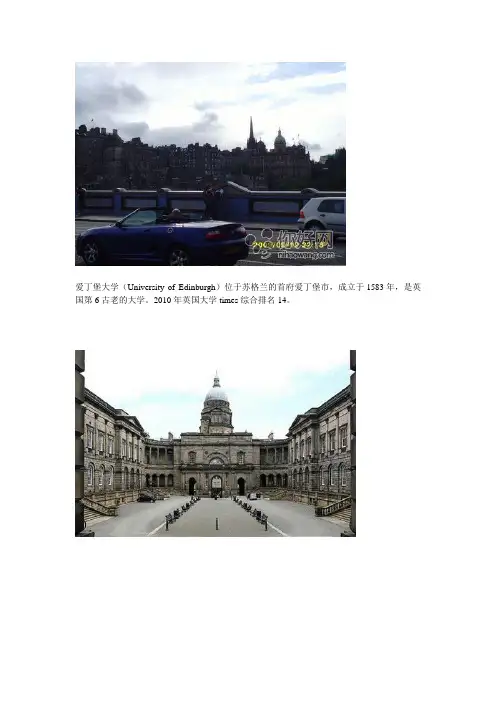
爱丁堡大学(University of Edinburgh)位于苏格兰的首府爱丁堡市,成立于1583年,是英国第6古老的大学。
2010年英国大学times综合排名14。
很多同学在选择英国留学时往往,还对英国大学的各种情况不甚明了,尤其对于英国哪些专业适合就业也不了解,其实英国大多数学校教学实力都非常强,不论哪所都可以说是名校,但英国的专业之间差距却很大,所以选择一门热门专业我,往往要比申请一所名校要重要的多,下面我们就来了解一下英国的热门专业。
1.英国留学热门专业——建筑学英国建筑学在国际上享有极高的声誉和地位。
主要名校有:谢菲尔德大学(University of Sheffield),该校建筑学的教学水平和研究水平在国际学术界享有很高的声誉,教学水平获得Excellent,研究水平得到5分。
爱丁堡大学(The University of Edinburgh),其建筑专业高居于专业前十强。
专业涵盖:建筑设计、建筑史和建筑学等方向。
另外,曼彻斯特大学、女王大学贝尔法斯特、利兹城市大学、卡迪夫大学都在建筑学专业有很高水平。
2.英国留学热门专业——教育学英国大学教育学实力排名为:Bristol、Sheffield、Cambridge、Warwick、Leicester、Leeds Metropolitan、Exeter、Cardiff、Aberdeen、Bath、King’s College、Keel、Dundee、Goldsmiths College、Queens Belfast、London South Bank、Surrey、Durham、York、Edinburgh。
3.英国留学热门专业——计算机与ITIT业是国内就业市场的“需才大户”,在此背景下,每年赴英留学人员中有25%的人选择IT及相关专业。
但从国内就业市场的行情看,传统的IT人才已趋饱和,而在移动通信、电子消费品生产方面以及网络通信、网络安全等新兴领域,人才需求量却很大。
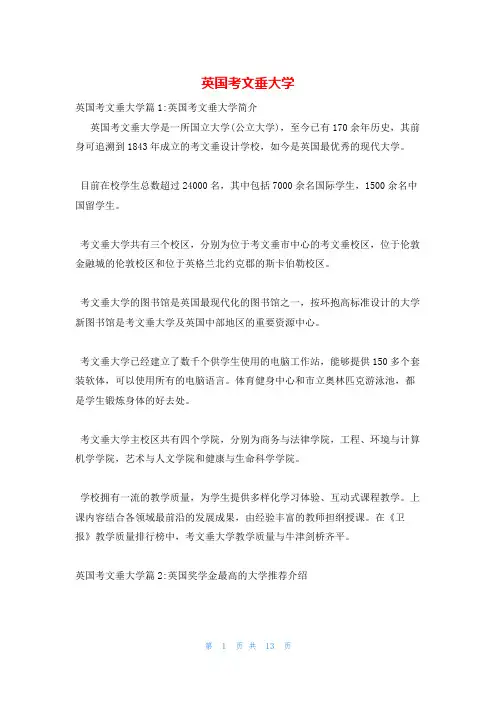
英国考文垂大学英国考文垂大学篇1:英国考文垂大学简介英国考文垂大学是一所国立大学(公立大学),至今已有170余年历史,其前身可追溯到1843年成立的考文垂设计学校,如今是英国最优秀的现代大学。
目前在校学生总数超过24000名,其中包括7000余名国际学生,1500余名中国留学生。
考文垂大学共有三个校区,分别为位于考文垂市中心的考文垂校区,位于伦敦金融城的伦敦校区和位于英格兰北约克郡的斯卡伯勒校区。
考文垂大学的图书馆是英国最现代化的图书馆之一,按环抱高标准设计的大学新图书馆是考文垂大学及英国中部地区的重要资源中心。
考文垂大学已经建立了数千个供学生使用的电脑工作站,能够提供150多个套装软体,可以使用所有的电脑语言。
体育健身中心和市立奥林匹克游泳池,都是学生锻炼身体的好去处。
考文垂大学主校区共有四个学院,分别为商务与法律学院,工程、环境与计算机学学院,艺术与人文学院和健康与生命科学学院。
学校拥有一流的教学质量,为学生提供多样化学习体验、互动式课程教学。
上课内容结合各领域最前沿的发展成果,由经验丰富的教师担纲授课。
在《卫报》教学质量排行榜中,考文垂大学教学质量与牛津剑桥齐平。
英国考文垂大学篇2:英国奖学金最高的大学推荐介绍为了减轻经济压力,除了打工,还可以积极努力地争取奖学金,不同的大学提供的奖学金不同,下面是百分网小编给大家带来的有关于英国留学的奖学近高的大学介绍,希望能够帮助到大家。
英国奖学金最高的大学介绍班戈大学 University of BangorInternational Scholarship 国际学生奖学金最高12023英镑,所有国家学生均可申请。
Alumni/Existing Students/Family Discount 校友/在读学生/家庭折扣1000英镑,所有国家学生均可申请,获得国际奖学金的学生也可以申请。
巴斯泉大学 Bath Spa UniversityVice Chancellor"s International Scholarship 副校长国际奖学金5000英镑,适用于在之前的教育阶段中的获得高成就的学生,申请者必须展示其关于创意,文化和企业等方面的独到见解。

利兹都市大学(LMU)是英国受欢迎的大学之一。
利兹是座落于英国中部地区约克郡的一个美丽,历史悠久以及拥有大量公共开放场地公园与花园的绿色城市。
2006年度泰晤士高等教育评奖中,利兹城市大学赢得了“对当地社区有杰出贡献”金奖和“年度大学”银奖。
获得这两个重要奖项,说明该校的教学质量极其优秀,物有所值。
利兹都市大学(LeedsMetropolitanUniversity)至今已有长达一百多年的历史。
立思辰留学360介绍,今天,利兹都市大学已经成为英国规模大的新型大学之一,有来自世界各国的22,000名学生在这里学习。
学生通过在利兹城市大学的学习将能够为未来的职业生涯奠定良好的基础。
由利兹都市大学所颁发的许多资格证书均获得英国以及外国专业机构的承认。
利兹都市大学专业设置
财经、建筑、医学、农林类、信息科学、法律、教育、语言、社科类等。
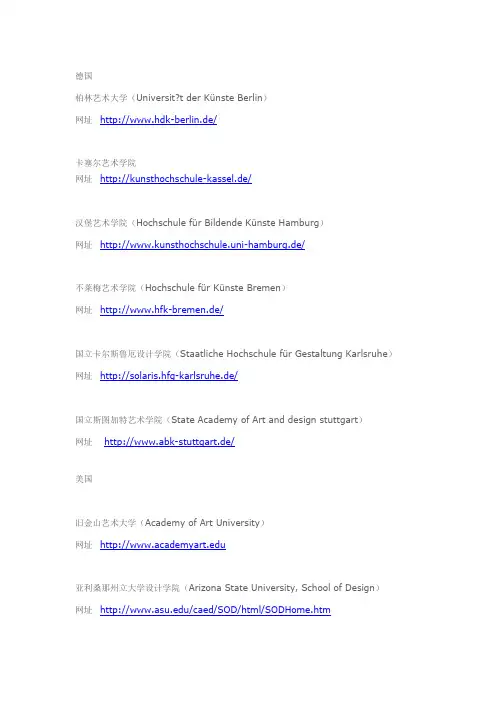
德国柏林艺术大学(Universit?t der Künste Berlin)网址http://www.hdk-berlin.de/卡塞尔艺术学院网址http://kunsthochschule-kassel.de/汉堡艺术学院(Hochschule für Bildende Künste Hamburg)网址http://www.kunsthochschule.uni-hamburg.de/不莱梅艺术学院(Hochschule für Künste Bremen)网址http://www.hfk-bremen.de/国立卡尔斯鲁厄设计学院(Staatliche Hochschule für Gestaltung Karlsruhe)网址http://solaris.hfg-karlsruhe.de/国立斯图加特艺术学院(State Academy of Art and design stuttgart)网址http://www.abk-stuttgart.de/美国旧金山艺术大学(Academy of Art University)网址亚利桑那州立大学设计学院(Arizona State University, School of Design)网址/caed/SOD/html/SODHome.htm劳德代尔堡艺术学院(The Art Institute of Fort Lauderdale)网址/奥本大学工业设计系(Auburn University, Department of Industrial Design)网址/ind/index.html加州州立大学长滩分校艺术学院(California State University, Long Beach, College of the Arts)网址/~cota/卡内基梅隆大学设计学院(Carnegie Mellon University, School of Design)网址/cfa/design罗彻斯特理工学院设计学院(Rochester Institute of Technology, School of Design)网址/~651www/乔治亚州理工学院工业设计系(GEORGIA INSTITUTE OF TECHNOLOGY, Industrial Design)网址/id/艺术中心设计学院(Art Center College of Design)网址/加州艺术学院(California Institute of the Arts)网址/奥蒂斯艺术与设计学院(Otis College of Art and Design)网址/芝加哥艺术学院(The School of the Art Institute of Chicago)网址/saic/罗得岛设计学院(Rhode Island School of Design)网址/克兰布鲁克艺术学院(Cranbrook Academy of Art)网址/北卡罗莱纳州立大学设计学院(North Carolina State University, College of Design)网址伊利诺斯大学艺术与设计学院(School of Art & Design, University of Illinois at Urbana-Champaign)网址/a+d/艺术大学(The University of the Arts)网址/马萨诸塞艺术学院(Massachusetts College of Art)网址/艺术博物馆学院(School of the Museum of Fine Arts)网址/俄亥俄州立大学(The Ohio State University)网址/哥伦布艺术与设计学院(Columbus College of Art & Design)网址/缅因艺术学院(Maine College of Art)网址/普拉特学院(Pratt Institute)网址/鹿特根大学卡姆艺术科学学院(Rutgers University-Camden College of Art & Sciences)网址/RUCAM/aboutUC.html鹿特根大学梅森格罗斯艺术学校(Rutgers University-Mason Gross School of the Arts)网址/孟菲斯艺术学院(Memphis College of Art)网址/视觉艺术学校(School of Visual Arts)网址/萨凡纳艺术与设计学院(Savannah College of Art and Design)网址/英国英国皇家艺术学院(Royal College of Art)网址/伦敦艺术大学(University of the Arts London)网址/中央圣马丁斯艺术设计学院(Central Saint Matins College of Art & Design)网址/切尔西艺术设计学院(Chelsea College of Art & Design)网址/坎贝威尔艺术学院(Camberwell College of Arts)网址/伦敦信息学院(London College of Communication)网址/伦敦时装学院(London College of Fashion)网址/巴斯斯帕大学学院(Bath Spa University College)网址/伯明翰艺术设计学院(Birmingham Institute of Art and Design)网址/home.htm格拉斯哥艺术学校(The Glasgow School of Art)网址爱丁堡艺术学院(Edinburgh College of Art)网址/肯特艺术设计学院(Kent Institute of Art and Design)网址/金斯顿大学(Kingston University)网址/利兹城市大学(Leeds Metropolitan University)网址/诺森比亚大学(Northumbria University)网址/诺丁汉特伦特大学(The Nottingham Trent University)网址/普利茅斯大学(University of Plymouth)网址/雷文斯本设计与传播学院(Ravensbourne College of Design & Communication)网址/胡佛汉顿大学(University of Wolverhampton)网址/日本东京艺术大学(Tokyo National University of Fine Arts and Music)网址http://www.geidai.ac.jp/千叶大学工学院工业设计系(National University Corporation Chiba University)网址http://www.chiba-u.ac.jp/京都市立艺术大学(Kyoto City University of Arts)网址http://www.kcua.ac.jp/筑波大学艺术系(University of Tsukuba, School of Art and Design)网址http://www.tsukuba.ac.jp/女子美术大学(Joshibi University of Art and Design)网址http://www.joshibi.ac.jp/京都工艺纤维大学(Kyoto Institute of Technology)武藏野美术大学(Musashino Art University)网址http://www.musabi.ac.jp/多摩美术大学(Tama Art University)网址http://www.tamabi.ac.jp/金泽美术工艺大学(Kanazawa College of Art)网址http://www.kanazawa-bidai.ac.jp/桑泽设计研究所(Kuwasawa Design School)该网址http://www.kds.ac.jp/大阪艺术大学(Osaka University of Arts)网址: http://www.osaka-geidai.ac.jp/九州艺术工科大学(Kyushu Institute of Design)网址http://www.kyushu-id.ac.jp/神户艺术工科大学(Kobe Design University)网址http://www.kobe-du.ac.jp/韩国汉城大学美术学院(Seoul National University, College of Fine Arts)国民大学(Kookmin University)网址http://www.kookmin.ac.kr/东西大学(Dongseo University)网址http://www.dongseo.ac.kr/芬兰赫尔辛基艺术设计大学(University of Art & Design Helsinki)网址http://www.uiah.fi/拉赫提设计学院(Lahti Institute of Design)网址thi.fi/丹麦丹麦皇家艺术学院视觉艺术学校(ROYAL DANISH ACADEMY OF FINE ARTS, SCHOOL OF VISUAL ART)网址http://www.kunstakademiet.dk丹麦皇家艺术学院建筑学校(ROYAL DANISH ACADEMY OF FINE ARTS, SCHOOL OF Architecture)网址http://www.karch.dk丹麦设计学院(The Danish School of Art & Design)澳大利亚悉尼理工大学工业设计系(UNIVERSITY OF TECHNOLOGY SYDNEY, Department of Industrial Design)网址.au/industrial/新南威尔士大学(The University of New South Wales)网址.au/皇家墨尔本理工大学(RMIT University)网址.au/堪培拉高等教育学院(Canberra College of Advanced Education)意大利欧洲设计学院(Istituto Europeo di Design)网址http://www.ied.it/多姆斯设计学院(Domus Academy)网址http://www.edidomus.it/domac爱尔兰爱尔兰国立艺术设计学院(The National College of Art & Design)网址http://www.ncad.ie瑞典瑞典国立艺术与设计学院(Konstfack University College of Arts Crafts and Design)网址http://www.konstfack.se/伍尔墨大学设计学院(Umea Institute of Design, Umea University)网址http://www.dh.umu.se瑞士苏黎士设计学院(Zurich School of Art & Design)网址http://www.hgkz.ch/捷克布拉格美术·建筑·设计学院(Academy of Arts, Architecture and Design in Prague)网址http://www.vsup.cz/main.php国内著名设计院校清华大学美术学院网址/publish/ad/中央美术学院网址:网址/中国美院网址/南京艺术学院设计学院网址/dc/鲁迅美术学院工业造型设计系网址/天津美术学院网址/广州美术学院设计分院网址/湖南大学设计艺术学院网址/江南大学设计学院网址/北京理工大学设计艺术学院网址/同济大学建筑与城市规划学院艺术设计系网址/上海交通大学设计系网址/广东工业大学艺术设计学院网址/yssjxy/webs/index.html武汉理工大学艺术与设计学院网址/sjxy/深圳大学艺术与设计学院网址/香港理工大学设计学院(The Hong Kong Polytechnic University, School of Design)网址.hk/welcome/index.html香港设计学院(Hong Kong School of Design)网址.hk/铭传大学设计学院(Ming Chuan University- School of Design)网址.tw/台湾艺术大学工艺设计学系(National Taiwan University of Arts)网址.tw/实践大学设计学院(Shih Chien University-College of Design)网址.tw/台北科技大学工业设计技术系网址.tw/台湾师范大学工业科技教育系网址.tw/index.htm。
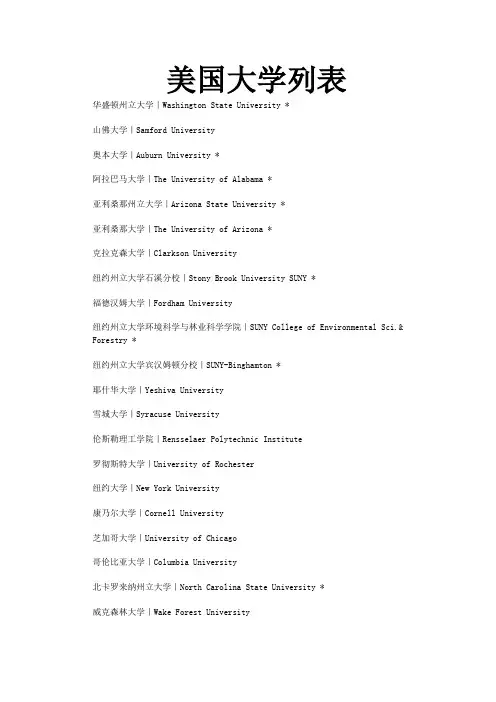
美国大学列表华盛顿州立大学|Washington State University *山佛大学|Samford University奥本大学|Auburn University *阿拉巴马大学|The University of Alabama *亚利桑那州立大学|Arizona State University *亚利桑那大学|The University of Arizona *克拉克森大学|Clarkson University纽约州立大学石溪分校|Stony Brook University SUNY *福德汉姆大学|Fordham University纽约州立大学环境科学与林业科学学院|SUNY College of Environmental Sci.& Forestry *纽约州立大学宾汉姆顿分校|SUNY-Binghamton *耶什华大学|Yeshiva University雪城大学|Syracuse University伦斯勒理工学院|Rensselaer Polytechnic Institute罗彻斯特大学|University of Rochester纽约大学|New York University康乃尔大学|Cornell University芝加哥大学|University of Chicago哥伦比亚大学|Columbia University北卡罗来纳州立大学|North Carolina State University *威克森林大学|Wake Forest University北卡罗来纳大学教堂山分校|University of North Carolina, Chapel Hill * 杜克大学|Duke University俄亥俄大学|Ohio University *戴顿大学|University of Dayton迈阿密大学|Miami University-Oxford俄亥俄州立大学|The Ohio State University-Columbus凯斯西储大学|Case Western Reserve University俄克拉荷马大学|The University of Oklahoma塔尔萨大学|University of Tulsa德雷塞尔大学|Drexel University匹兹堡大学|University of Pittsburgh宾西法尼亚州立大学|The Pennsylvania State University-University Park 理海大学|Lehigh University卡内基梅隆大学|Carnegie Mellon University宾夕法尼亚大学|University of Pennsylvania布朗大学|Brown University南卡罗来纳大学哥伦比亚分校|University of South Carolina Columbia克莱姆森大学|Clemson University田纳西大学|The University of Tennessee范德比尔特大学|Vanderbilt University德克萨斯基督教大学|Texas Christian University贝勒大学|Baylor University南卫理公会大学|Southern Methodist University德克萨斯 A&M 大学|Texas A&M University得克萨斯州大学奥斯汀分校|University of Texas at Austin莱斯大学|Rice University佛蒙特大学|The University of Vermont弗吉尼亚理工学院暨州立大学|Virginia Polytechnic Institute and State University威廉及玛丽学院|The College of William & Mary弗吉尼亚大学|University of Virginia马凯特大学|Marquette University威斯康辛大学麦迪逊分校|University of Wisconsin-Madison阿肯色大学|University of Arkansas *圣地亚哥大学|University of San Diego加州大学河滨分校|University of California Riverside *太平洋大学|University of the Pacific佩珀代因大学|Pepperdine University加州大学圣克鲁兹分校|University of California Santa Cruz *加州大学尔湾分校|University of California, Irvine *圣塔芭芭拉加州大学|University of California, Santa Barbara *加州大学戴维斯分校|University of California, Davis *加利福尼亚大学圣地牙哥分校|University of California, San Diego *南加州大学|University of Southern California加州大学洛杉矶分校|University of California, Los Angeles *加州大学伯克利分校|University of California, Berkeley *加州理工学院|California Institute of Technology斯坦福大学|Stanford University科罗拉多州立大学|Colorado State University *丹佛大学|University of Denver科罗拉多大学博尔德分校|University of Colorado Boulder *科罗拉多矿业学院|Colorado School of Mines *康涅狄格大学|University of Connecticut *耶鲁大学|Yale University哥伦比亚特区 | District of Columbia美国大学|American University美国天主教大学|The Catholic University of America霍华德大学|Howard University乔治华盛顿大学|The George Washington Univeristy乔治敦大学|Georgetown University佛罗里达州立大学|Florida State University *迈阿密大学|University of Miami佛罗里达大学|University of Florida *乔治亚大学|University of Georgia *佐治亚理工学院|Georgia Institute of Technology *埃默理大学|Emory University特拉华大学|University of Delaware *芝加哥洛约拉大学|Loyola University Chicago伊利诺理工大学|Illinois Institute of Technology伊利诺伊大学厄巴纳-香槟分校|University of Illinois at Urbana-Champaign * 美国西北大学|Northwestern University普渡大学|Purdue University *印地安那大学伯明顿分校|Indiana University,Bloomington美国圣母大学|University of Notre Dame爱荷华大学|The University of Iowa *爱荷华州立大学|Iowa State University *堪萨斯州立大学|Kansas State University *堪萨斯大学|The University of Kansas *肯塔基大学|University of Kentucky *杜兰大学|Tulane University马里兰大学学院市分校|University of Maryland,College Park *约翰·霍普金斯大学|The Johns Hopkins UniversityWilliams College|威廉斯姆学院艾姆赫斯特学院|Amherst College马萨诸塞大学安姆斯特分校|University of Massachusetts Amherst * 东北大学|Northeastern University克拉克大学|Clark University伍斯特理工学院|Worcester Polytechnic Institute波士顿大学|Boston University波士顿学院|Boston College布兰迪斯大学|Brandeis University塔夫茨大学|Tufts University密歇根理工大学|Michigan Technological University *密歇根州立大学|Michigan State University *密歇根大学安娜堡分校|University of Michigan, Ann Arbor *明尼苏达大学-双城校区|University of Minnesota-Twin Cities *密苏里大学理工学院|Missouri University of Science and Technology *密苏里大学哥伦比亚分校|University of Missouri Columbia *圣路易斯大学|Saint Louis University圣路易斯华盛顿大学|Washington University in St. Louis新罕布什尔大学|University of New Hampshire *达特茅斯学院|Dartmouth College新泽西理工学院|New Jersey Institute of Technology *斯蒂文斯理工学院|Stevens Institute of Technology *罗格斯,新泽西州立大学-新布朗斯威克校区|Rutgers, The State University of New Jersey,New Brun *普林斯顿大学|Princeton University俄勒冈大学|University of Oregon *内布拉斯加大学林肯分校|University of Nebraska Lincoln *杨百翰大学|Brigham Young University Provo英国大学列表安格利亚鲁斯金大学(Anglia Ruskin University)伦敦艺术大学(University of the Arts London)坎贝威尔艺术学院中央圣马丁艺术与设计学院切尔西艺术与设计学院伦敦传播学院伦敦时装学院温布尔登艺术学院阿斯顿大学(Aston University)巴斯大学(University of Bath)巴斯泉大学(Bath Spa University)伯明翰大学(University of Birmingham,Birmingham University)Bishop Grosseteste College,Lincoln,England波顿大学(University of Bolton)伯恩茅斯大学(Bournemouth University)布拉福大学(University of Bradford,Bradford University)布莱顿大学(University of Brighton)布里斯托大学(University of Bristol)布鲁内尔大学(Brunel University)白金汉大学(University of Buckingham)剑桥大学(University of Cambridge)坎特伯里基督教堂大学(Canterbury Christ Church University)中英格兰大学(University of Central England,Birmingham)中兰开夏大学(University of Central Lancashire)彻斯特大学(University of Chester)奇彻斯特大学(University of Chichester)伦敦城市大学(City University, London)考文垂大学(Coventry University)克莱菲尔德大学(Cranfield University)德蒙福特大学(De Montfort University)德比大学(University of Derby,Derby University)德伦大学(Durham University)东安格里亚大学(University of East Anglia, Norwich)东伦敦大学(University of East London)艾塞克斯大学(University of Essex)艾希特大学(University of Exeter,Exeter University)格罗斯特郡大学(University of Gloucestershire)格林威治大学(University of Greenwich)赫福郡大学(University of Hertfordshire,Hatfield)哈德斯菲尔德大学(Huddersfield University)赫尔大学(University of Hull)基尔大学(Keele University,Staffordshire)肯特大学(University of Kent,Canterbury)金士顿大学(Kingston University,South West London)兰卡斯特大学(Lancaster University)利兹音乐学院(Leeds College of Music)里兹都会大学(Leeds Metropolitan University)里兹大学(University of Leeds)College of Ripon and York St. JohnTrinity and All Saints College莱斯特大学University of Leicester林肯大学(University of Lincoln)利物浦大学(University of Liverpool)Liverpool John Moores University利物浦希望大学(Liverpool Hope University)伦敦帝国学院(Imperial College London)伦敦大学(University of London)柏贝克学院Birkbeck College科陶德美术学院Courtauld Institute of Art金匠学院Goldsmiths College海斯罗珀学院Heythrop College教育学院Institute of Education伦敦国王学院King's College London伦敦商学院London Business School伦敦政治经济学院London School of Economics and Political Science伦敦卫生及热带医学学院London School of Hygiene and Tropical Medicine 玛莉皇后学院Queen Mary and WestfieldSt Bartholomew's and the Royal London School of Medicine and Dentistry皇家音乐学院Royal Academy of Music皇家哈洛威学院Royal Holloway圣乔治医学院St. George's高级研究学院School of Advanced Studies亚非学院School of Oriental and African Studies药剂学院School of Pharmacy伦敦大学学院University College LondonEastman Dental InstituteInstitute of Child HealthInstitute of NeurologyInstitute of OphthalmologyRoyal Free and University College Medical SchoolSchool of Slavonic and East European StudiesSlade School of Fine Art伦敦都会大学(London Metropolitan University)伦敦南岸大学(London South Bank University)罗浮堡大学(Loughborough University)路顿大学(University of Luton)曼彻斯特都会大学(Manchester Metropolitan University)曼彻斯特大学(University of Manchester)曼彻斯特商学院(Manchester Business School)密德塞克斯大学(Middlesex University,West London)新堡大学(Newcastle University)Newman College of Higher Education,Birmingham北安普顿大学(University of Northampton)诺桑比亚大学(University of Northumbria,Carlisle,England and Newcastle upon Tyne)Norwich School of Art and Design诺丁汉大学(Nottingham University)诺丁汉特伦特大学(Nottingham Trent University)英国公开大学(The Open University,Milton Keynes)牛津大学(University of Oxford)西敏寺学院Westminster College牛津布鲁克斯大学(Oxford Brookes University)普利茅斯大学(Plymouth University)普兹茅斯大学(The University of Portsmouth)Ravensbourne College of Design and Communication,London 瑞丁大学(Reading University)Roehampton UniversityRose Bruford College,Sidcup,KentRoyal College of ArtRoyal College of MusicRoyal College of NursingRoyal College of PhysiciansRoyal Northern College of Music,ManchesterRoyal Veterinary CollegeSt.Martin's CollegeSt.Mary's College,Twickenham,West London索耳福大学(University of Salford)雪菲尔大学(University of Sheffield)雪菲尔哈伦大学(Sheffield Hallam University)南安普敦大学(University of Southampton)Southampton Solent UniversitySouthampton Institue of Higher EducationStaffordshire University桑德兰大学(Sunderland University)Surrey Institute of Art and Design萨里大学(University of Surrey,Guildford)萨塞克斯大学(University of Sussex,Brighton)University of Teesside泰晤士河谷大学(Thames Valley University)Trinity College of Music,LondonUniversity College of St.Mark & St.John,Plymouth,England University College,ScarboroughUniversity College,WarringtonUniversity College,Writtle,Chelmsford,England华威大学(University of Warwick)西英格兰大学(University of the West of England,Bristol)西敏寺大学(University of Westminster,London)Wimbledon School of Art温彻斯特大学(University of Winchester)University of WolverhamptonUniversity of Worcester约克大学(University of York)North Riding College卡迪夫大学(Cardiff University)格拉摩根大学(University of Glamorgan)威尔士大学(University of Wales)阿伯里斯特威斯大学(Aberystwyth University)班戈大学(Bangor University)威尔士大学卡地夫学院(University of Wales Institute, Cardiff)威尔士大学,兰姆彼得(University of Wales, Lampeter)威尔士大学,纽波特(University of Wales, Newport)斯旺西大学(Swansea University)贝尔法斯特女王大学(Queen's University)贝尔法斯特圣玛丽学院(St. Mary's College)贝尔法斯特斯却莱米尔斯学院(Stranmillis College,Stranmillis University College)阿尔斯特大学(University of Ulster)阿伯丁大学(University of Aberdeen)亚伯泰大学(University of Abertay,Dundee)邓迪大学(University of Dundee)爱丁堡大学(University of Edinburgh)格拉斯哥大学(Glasgow University,University of Glasgow)格拉斯哥卡利多尼安大学(Glasgow Caledonian University)赫里奥特-瓦特大学(Heriot-Watt University)奈比尔大学(Napier University)佩斯利大学(University of Paisley)玛格丽特皇后大学(Queen Margaret University)罗伯特哥顿大学(The Robert Gordon University,Aberdeen)圣安德鲁斯大学(University of St Andrews)史特灵大学(University of Stirling)史崔克莱德大学(University of Strathclyde, Glasgow)日本大学列表国立大学(97所)北海道大学(北海道大学)北海道教育大学(北海道教育大学)室蘭工業大学 (室兰工业大学)小樽商科大学(小樽商科大学)帯広畜産大学 (带广畜产大学)旭川医科大学(旭川医科大学)北見工業大学 (北见工业大学)弘前大学(弘前大学)岩手大学 (岩手大学)東北大学 (东北大学)宮城教育大学(宫城教育大学)秋田大学(秋田大学)山形大学 (山形大学)福島大学 (福岛大学)茨城大学 (茨城大学)図書館情報大学(图书馆情报大学):已并入筑波大学筑波大学(筑波大学)宇都宮大学(宇都宫大学)群馬大学(群马大学)埼玉大学(埼玉大学)千葉大学(千叶大学)東京大学(东京大学)東京医科歯科大学(东京医科牙科大学)東京外国語大学(东京外国语大学)東京学芸大学(东京学艺大学)東京農工大学(东京农工大学東京芸術大学(东京艺术大学)東京工業大学(东京工业大学)東京商船大学(东京商船大学)東京水産大学(东京水产大学)お茶の水女子大学(御茶水女子大学)政策研究大学院大学(政策研究大学院大学)電気通信大学(电气通信大学)一橋大学(一桥大学)総合研究大学院大学(综合研究大学院大学)横浜国立大学(横浜国立大学)新潟大学(新潟大学)長岡技術科学大学(长冈技术科学大学)上越教育大学(上越教育大学)富山大学(富山大学)富山医科薬科大学(富山医科药科大学)北陸先端科学技術大学院大学(北陆先端科学技术大学院大学)金沢大学(金泽大学)福井大学(福井大学)福井医科大学(福井医科大学)山梨大学(山梨大学)山梨医科大学(山梨医科大学):已并入山梨大学信州大学(信州大学)岐阜大学(岐阜大学)静岡大学(静冈大学)浜松医科大学(浜松医科大学)名古屋大学(名古屋大学)愛知教育大学(爱知教育大学)名古屋工業大学(名古屋工业大学)豊橋技術科学大学(丰桥技术科学大学)三重大学(三重大学)滋賀大学(滋贺大学)滋賀医科大学(滋贺医科大学)京都大学(京都大学)京都教育大学(京都教育大学)京都工芸繊維大学(京都工艺纤维大学)大阪大学(大阪大学)大阪外国語大学(大阪外国语大学)大阪教育大学(大阪教育大学)兵庫教育大学(兵库教育大学)神戸大学(神户大学)神戸商船大学(神户商船大学)奈良教育大学(奈良教育大学)奈良女子大学(奈良女子大学)奈良先端科学技術大学院大学(奈良先端科学技术大学院大学)和歌山大学(和歌山大学)鳥取大学(鸟取大学)島根大学(岛根大学)島根医科大学(岛根医科大学)岡山大学(冈山大学)広島大学(广岛大学)山口大学(山口大学)徳島大学(德岛大学)鳴門教育大学(鸣门教育大学)香川大学(香川大学)香川医科大学(香川医科大学)愛媛大学(爱媛大学)高知大学(高知大学)福岡教育大学(福冈教育大学)九州大学(九州大学)九州芸術工科大学(九州艺术工科大学)九州工業大学(九州工业大学)佐賀大学(佐贺大学)佐賀医科大学(佐贺医科大学)長崎大学(长崎大学)熊本大学(熊本大学)大分大学(大分大学)大分医科大学(大分医科大学)宮崎大学(宫崎大学)宮崎医科大学(宫崎医科大学)鹿児島大学(鹿儿岛大学)鹿屋体育大学(鹿屋体育大学)琉球大学(琉球大学)公立大学(75所)公立函館未来大学(公立函馆未来大学)釧路公立大学(钏路公立大学)札幌医科大学(札幌医科大学)青森県立保健大学(青森县立保健大学)青森公立大学(青森公立大学)岩手県立大学(岩手县立大学)秋田県立大学(秋田县立大学)山形県立保健医療大学(山形县立保健医疗大学)宮城大学(宫城大学)新潟県立看護大学(新潟县立看护大学)会津大学(会津大学)福島県立医科大学(福岛县立医科大学)茨城県立医療大学(茨城县立医疗大学)群馬県立女子大学(群马县立女子大学)高崎経済大学(高崎经济大学)前橋工科大学(前桥工科大学)埼玉県立大学(埼玉县立大学)東京都立大学(东京都立大学)東京都立科学技術大学(东京都立科学技术大学)東京都立保健科学大学(东京都立保健科学大学)横浜市立大学(横浜市立大学)神奈川県立保健福祉大学(神奈川县立保健福利大学)富山県立大学(富山县立大学)石川県立看護大学(石川县立看护大学)金沢美術工芸大学(金泽美术工艺大学)福井県立大学(福井县立大学)山梨県立看護大学(山梨县立看护大学)長野県看護大学(长野县看护大学)岐阜県立看護大学(岐阜县立看护大学)岐阜薬科大学(岐阜药科大学)静岡県立大学(静冈县立大学)愛知県立大学(爱知县立大学)愛知県立看護大学(爱知县立看护大学)愛知県立芸術大学(爱知县立艺术大学)名古屋市立大学(名古屋市立大学)三重県立看護大学(三重县立看护大学)滋賀県立大学(滋贺县立大学)京都市立芸術大学(京都市立艺术大学)京都府立大学(京都府立大学)京都府立医科大学(京都府立医科大学)大阪女子大学(大阪女子大学)大阪府立大学(大阪府立大学)大阪市立大学(大阪市立大学)大阪府立看護大学(大阪府立看护大学)神戸市外国語大学(神户市外国语大学)神戸市看護大学(神户市看护大学)神戸商科大学(神户商科大学)姫路工業大学(姬路工业大学)兵庫県立看護大学(兵库县立看护大学)奈良県立医科大学(奈良县立医科大学)奈良県立大学(奈良县立大学)和歌山県立医科大学(和歌山县立医科大学)岡山県立大学(冈山县立大学)島根県立大学(岛根县立大学)広島県立大学(广岛县立大学)県立広島女子大学(县立广岛女子大学)広島市立大学(广岛市立大学)尾道大学(尾道大学)広島県立保健福祉大学(广岛县立保健福利大学)下関市立大学(下关市立大学)山口県立大学(山口县立大学)高知女子大学(高知女子大学)北九州市立大学(北九州市立大学)九州歯科大学(九州牙科大学)福岡県立大学(福冈县立大学)福岡女子大学(福冈女子大学)県立長崎シーボルト大学(县立长崎斯博路德大学)長崎県立大学(长崎县立大学)熊本県立大学(熊本县立大学)大分県立看護科学大学(大分县立看护科学大学)宮崎県立看護大学(宫崎县立看护大学)宮崎公立大学(宫崎公立大学)沖縄県立看護大学(冲绳县立看护大学)沖縄県立芸術大学(冲绳县立艺术大学)。
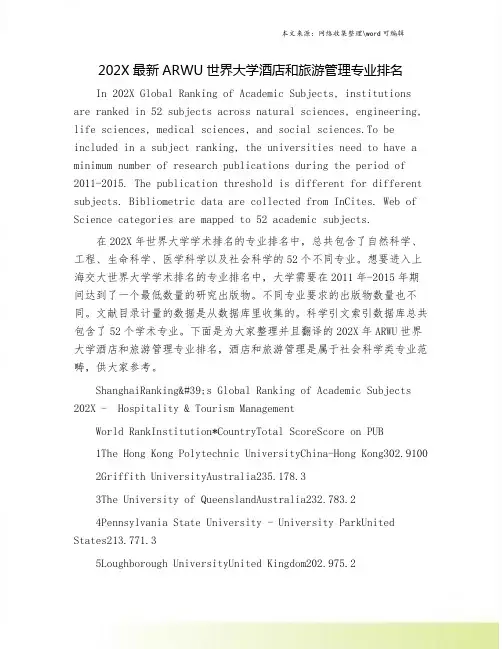
202X最新ARWU世界大学酒店和旅游管理专业排名In 202X Global Ranking of Academic Subjects, institutions are ranked in 52 subjects across natural sciences, engineering, life sciences, medical sciences, and social sciences.To be included in a subject ranking, the universities need to have a minimum number of research publications during the period of 2011-2015. The publication threshold is different for different subjects. Bibliometric data are collected from InCites. Web of Science categories are mapped to 52 academic subjects.在202X年世界大学学术排名的专业排名中,总共包含了自然科学、工程、生命科学、医学科学以及社会科学的52个不同专业。
想要进入上海交大世界大学学术排名的专业排名中,大学需要在2011年-2015年期间达到了一个最低数量的研究出版物。
不同专业要求的出版物数量也不同。
文献目录计量的数据是从数据库里收集的。
科学引文索引数据库总共包含了52个学术专业。
下面是为大家整理并且翻译的202X年ARWU世界大学酒店和旅游管理专业排名,酒店和旅游管理是属于社会科学类专业范畴,供大家参考。
ShanghaiRanking's Global Ranking of Academic Subjects 202X - Hospitality & Tourism ManagementWorld RankInstitution*CountryTotal ScoreScore on PUB1The Hong Kong Polytechnic UniversityChina-Hong Kong302.9100 2Griffith UniversityAustralia235.178.33The University of QueenslandAustralia232.783.24Pennsylvania State University - University ParkUnited States213.771.35Loughborough UniversityUnited Kingdom202.975.26University of SurreyUnited Kingdom192.9517Purdue University - West LafayetteUnited States191.960.8 8Virginia Polytechnic Institute and State UniversityUnited States186.449.19Bournemouth UniversityUnited Kingdom184.15410University of BirminghamUnited Kingdom183.655.711Kyung Hee UniversitySouth Korea181.756.112University of FloridaUnited States180.857.113Temple UniversityUnited States180.760.614University of OtagoNew Zealand17455.915Texas A&M UniversityUnited States173.354.716The University of WaikatoNew Zealand170.25317Leeds Metropolitan UniversityUnited Kingdom168.861.817Sun Yat-sen UniversityChina168.845.519James Cook UniversityAustralia165.158.520University of Central FloridaUnited States16548.921Monash UniversityAustralia164.848.722Southern Cross UniversityAustralia164.550.723University of WaterlooCanada163.24624Sejong UniversitySouth Korea161.944.225Cornell UniversityUnited States158.841.226University of South AustraliaAustralia156.852.127Washington State UniversityUnited States156.142.128University of Nevada-Las VegasUnited States155.641.529University of KoelnGermany152.948.930The University of New South WalesAustralia152.242.931Michigan State UniversityUnited States151.24732University of South Carolina - ColumbiaUnitedStates150.144.733Arizona State UniversityUnited States149.842.634University of JohannesburgSouth Africa148.341.835Victoria UniversityAustralia147.154.736University of StrathclydeUnited Kingdom146.54537University of OttawaCanada146.447.938University of AlbertaCanada144.652.539University of British ColumbiaCanada144.442.340Florida State UniversityUnited States143.146.241University of ExeterUnited Kingdom141.640.442Ben-Gurion University of the NegevIsrael140.935.243Curtin UniversityAustralia139.135.644Oxford Brookes UniversityUnited Kingdom138.436.845University of Illinois at Urbana-ChampaignUnitedStates138.146.546University of Central LancashireUnited Kingdom13843.447University of WollongongAustralia137.939.248University of CanterburyNew Zealand137.74149University of Massachusetts AmherstUnited States136.238.450University of HoustonUnited States13536.851-75AUT UniversityNew Zealand44.251-75Brock UniversityCanada42.151-75Cardiff Metropolitan UniversityUnited Kingdom 41.251-75College of CharlestonUnited States27.551-75Deakin UniversityAustralia39.551-75East Carolina UniversityUnited States35.251-75Indiana University BloomingtonUnited States 40.751-75KU LeuvenBelgium38.751-75La Trobe UniversityAustralia43.951-75Linnaeus UniversitySweden33.651-75Lund UniversitySweden34.651-75National Cheng Kung UniversityChina-Taiwan29.251-75Oklahoma State UniversityUnited States32.551-75Sheffield Hallam UniversityUnited Kingdom44.751-75The Ohio State University - ColumbusUnited States 36.251-75The University of Western AustraliaAustralia34.651-75Universidad de Las Palmas de Gran CanariaSpain 29.951-75University of AlicanteSpain30.751-75University of BathUnited Kingdom31.451-75University of NottinghamUnited Kingdom33.651-75University of OuluFinland38.151-75University of Technology, SydneyAustralia4551-75University of the Balearic IslandsSpain32.951-75University of WageningenNetherlands32.551-75VU University AmsterdamNetherlands31.476-100Bangor UniversityUnited Kingdom28.476-100Brunel UniversityUnited Kingdom35.276-100Clemson UniversityUnited States33.676-100Dong-A UniversitySouth Korea28.476-100Federation University AustraliaAustralia33.276-100Ghent UniversityBelgium24.476-100Iowa State UniversityUnited States32.276-100McGill UniversityCanada29.276-100National Taiwan Normal UniversityChina-Taiwan 33.976-100Norwegian School of Sport SciencesNorway40.476-100Pusan National UniversitySouth Korea30.776-100Queensland University of TechnologyAustralia32.576-100The University of CalgaryCanada41.876-100The University of GeorgiaUnited States34.676-100University of GothenburgSweden33.276-100University of HullUnited Kingdom31.476-100University of InnsbruckAustria26.776-100University of LisbonPortugal33.976-100University of Minnesota, Twin CitiesUnited States 36.876-100University of Missouri - ColumbiaUnited States 29.976-100University of StirlingUnited Kingdom4176-100University of Western SydneyAustralia35.276-100Victoria University of WellingtonNew Zealand37.876-100Western UniversityCanada35.676-100Wilfrid Laurier UniversityCanada30.3* Institutions within the same rank range are listed alphabetically.202X年上海交大世界大学学术排名——酒店和旅游管理专业排名世界大学排名大学名称*所在国家获得总分大学所出版的论文数量得分第1位香港理工大学中国香港302.9100第2位格里菲斯大学澳大利亚235.178.3第3位昆士兰大学澳大利亚232.783.2第4位宾夕法尼亚州立大学帕克分校美国213.771.3第5位拉夫堡大学英国202.975.2第6位萨里大学英国192.951第7位普渡大学西拉法叶分校美国191.960.8第8位弗吉尼亚理工学院暨州立大学美国186.449.1第9位伯恩茅斯大学英国184.154第10位伯明翰大学英国183.655.7第11位庆熙大学韩国181.756.1第12位佛罗里达大学美国180.857.1第13位天普大学美国180.760.6第14位奥塔哥大学新西兰17455.9第15位德克萨斯农工大学美国173.354.7第16位怀卡托大学新西兰170.253第17位利兹都市大学英国168.861.8第17位中山大学中国168.845.5第19位詹姆斯库克大学澳大利亚165.158.5第20位中佛罗里达大学美国16548.9第21位莫纳什大学澳大利亚164.848.7第22位南十字星大学澳大利亚164.550.7第23位滑铁卢大学加拿大163.246第24位世宗大学韩国161.944.2第25位康奈尔大学美国158.841.2第26位南澳大学澳大利亚156.852.1第27位华盛顿州立大学美国156.142.1第28位内华达大学拉斯维加斯分校美国155.641.5 第29位科隆大学德国152.948.9第30位新南威尔士大学澳大利亚152.242.9第31位密歇根州立大学美国151.247第32位南卡罗来纳大学哥伦比亚分校美国150.144.7 第33位亚利桑那州立大学美国149.842.6第34位约翰内斯堡大学南非148.341.8第35位维多利亚大学澳大利亚147.154.7第36位斯特拉斯克莱德大学英国146.545第37位渥太华大学加拿大146.447.9第38位阿尔伯塔大学加拿大144.652.5第39位不列颠哥伦比亚大学加拿大144.442.3第40位佛罗里达州立大学美国143.146.2第41位埃克塞特大学英国141.640.4第42位本古里安大学以色列140.935.2第43位科廷大学澳大利亚139.135.6第44位牛津布鲁克大学英国138.436.8第45位伊利诺伊大学香槟分校美国138.146.5第46位中央兰开夏大学英国13843.4第47位伍伦贡大学澳大利亚137.939.2第48位坎特伯雷大学新西兰137.741第49位马赛诸塞大学安姆斯特分校美国136.238.4 第50位休斯敦大学美国13536.8第51-75位奥克兰理工大学新西兰44.2第51-75位布鲁克大学加拿大42.1第51-75位卡迪夫城市大学英国41.2第51-75位查尔斯顿学院美国27.5第51-75位迪肯大学澳大利亚39.5第51-75位东卡罗来纳州立大学美国35.2第51-75位印第安纳大学伯明顿分校美国40.7第51-75位天主教鲁汶大学比利时38.7第51-75位拉筹伯大学澳大利亚43.9第51-75位林奈大学瑞典33.6第51-75位隆德大学瑞典34.6第51-75位国立成功大学中国台湾29.2第51-75位俄克拉荷马州立大学美国32.5第51-75位谢菲尔德哈勒姆大学英国44.7第51-75位俄亥俄州立大学哥伦布分校美国36.2第51-75位西澳大学澳大利亚34.6第51-75位加那利群岛拉斯帕尔马斯大学西班牙29.9第51-75位阿利坎特大学西班牙30.7第51-75位巴斯大学英国31.4第51-75位诺丁汉大学英国33.6第51-75位奥卢大学芬兰38.1第51-75位悉尼科技大学澳大利亚45第51-75位巴利阿里群岛大学西班牙32.9第51-75位瓦格宁根大学荷兰32.5第51-75位阿姆斯特丹自由大学荷兰31.4第76-100位班戈大学英国28.4第76-100位布鲁内尔大学英国35.2第76-100位克莱姆森大学美国33.6第76-100位东亚大学韩国28.4第76-100位澳大利亚联邦大学澳大利亚33.2第76-100位根特大学比利时24.4第76-100位爱荷华州立大学美国32.2第76-100位麦吉尔大学加拿大29.2第76-100位国立台湾师范大学中国台湾33.9第76-100位挪威体育学院挪威40.4第76-100位釜山国立大学韩国30.7第76-100位昆士兰科技大学澳大利亚32.5第76-100位卡尔加里大学加拿大41.8第76-100位佐治亚大学美国34.6第76-100位哥德堡大学瑞典33.2第76-100位赫尔大学英国31.4第76-100位因斯布鲁克大学奥地利26.7第76-100位里斯本大学葡萄牙33.9第76-100位明尼苏达大学双城分校美国36.8第76-100位密苏里大学哥伦比亚分校美国29.9第76-100位斯特灵大学英国41第76-100位西悉尼大学澳大利亚35.2第76-100位惠灵顿维多利亚大学新西兰37.8第76-100位韦仕敦大学(西安大略大学)加拿大35.6第76-100位劳瑞尔大学加拿大30.3* 相同排名区间内的大学是按照字母顺序排列的。

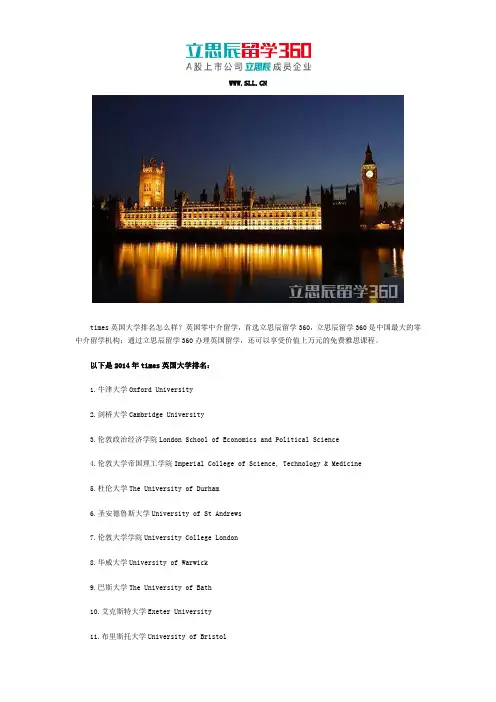
times英国大学排名怎么样?英国零中介留学,首选立思辰留学360,立思辰留学360是中国最大的零中介留学机构;通过立思辰留学360办理英国留学,还可以享受价值上万元的免费雅思课程。
以下是2014年times英国大学排名:1.牛津大学Oxford University2.剑桥大学Cambridge University3.伦敦政治经济学院London School of Economics and Political Science4.伦敦大学帝国理工学院Imperial College of Science, Technology & Medicine5.杜伦大学The University of Durham6.圣安德鲁斯大学University of St Andrews7.伦敦大学学院University College London8.华威大学University of Warwick9.巴斯大学The University of Bath10.艾克斯特大学Exeter University11.布里斯托大学University of Bristol12.兰卡斯特大学Lancaster University13.约克大学University of York14.爱丁堡大学Edinburgh University15.格拉斯哥大学Glasgow University16.拉夫堡大学Loughborough University17.莱斯特大学Leicester University18.萨塞克斯大学Sussex University18.南安普敦大学Southampton University20.诺丁汉大学The University of Nottingham21.谢菲尔德大学The University of Sheffield22.伦敦大学国王学院King‘s College London, University of London23.英国纽卡斯尔大学Newcastle University24.瑞丁大学Reading University24.伯明翰大学The University of Birmingham26.萨里大学Surrey University27.伦敦大学皇家霍洛威学院Royal Holloway, University of London28.东英吉利大学University of East Anglia (UEA)29.利物浦大学Liverpool University30.利兹大学Leeds University31.伦敦大学亚非研究学院School of Oriental and African Studies (SOAS)32.卡迪夫大学Cardiff University33.曼彻斯特大学The University of Manchester34.坎特伯雷肯特大学University of Kent at Canterbury35.贝尔法斯特女王大学The Queen’s University of Belfast University36.斯特拉思克莱德大学Strathclyde University36.阿斯顿大学Aston University38.伦敦大学玛利皇后学院Queen Mary and Westfield College39.阿伯丁大学Aberdeen University40.艾塞克斯大学Essex University41.新白金汉大学Buckinghamshire New University42.赫瑞-瓦特大学Heriot-Watt University43.布鲁内尔大学Brunel University44.邓迪大学Dundee University45.英国基尔大学Britain Keele University46.城市大学City University47.赫威尔士大学阿伯瑞特威斯分校University of Wales, Aberystwyth48.伦敦大学金史密斯学院Goldsmiths College, University of London49.赫尔大学Hull University50.斯德灵大学Stirling University51.罗伯特高登大学Robert Gordon University52.威尔士大学斯旺西分校University of Wales,Swansea52.牛津布鲁克斯大学Oxford Brookes University52.英国林肯大学Britain University of Lincoln55.考文垂大学Coventry University56.威尔士大学班戈分校University of Wales, Bangor57.哈德斯菲尔德大学Huddersfield University58.诺桑比亚大学University of Northumbria59.曼切斯特城市大学Manchester Metropolitan University60.伦敦艺术大学University of the Arts London61.Chichester62.西英格兰大学University of the West of England63.朴次茅斯大学Portsmouth University64.普利茅斯大学Plymouth University65.格洛斯特郡大学University of Gloucestershire65.阿尔斯特大学University of Ulster67.布拉德福德大学Bradford University68.赫特福德郡大学Hertfordshire University69.布莱顿大学Brighton University70.Bath Spa71.UCLAN72.德蒙福特大学De Montfort University73.边山大学Edge Hill University73.谢菲尔德哈莱姆大学Sheffield Hallam University75.伯明翰城市大学(BCU)BIRMINGHAM City University75.Winchester77.桑德兰大学Sunderland University78.CMU78.诺丁汉特伦特大学Nottingham Trent University80.York St John81.伯恩茅斯大学Bournemouth University81.格拉斯哥卡利多尼亚大学Glasgow Caledonian University83.Queen Margaret Edinburgh84.纳皮尔大学Napier University85.Canterbury Christ Church86.萨里大学,鲁尔汉普顿University of Surrey, Roehampton87.梯塞德大学Teesside University88.Bedfordshire89.德比大学Derby University90.米都塞克斯大学Middlesex University91.萨尔福德大学Salford University91.格林尼治大学Greenwich University93.Liverpool JM93.伍斯特大学The University of Worcester95.格拉摩根大学Glamorgan University95.威斯敏斯特大学University of Westminster97.Cumbria97.Glyndwr99.北安普顿大学Northampton University100.斯坦福郡大学Staffordshire University101.金斯顿大学Kingston University102.城市大学City University103.UCA104.利兹城市大学Leeds Metropolitan Universit105.Trinity St Davids106.新白金汉大学Buckinghamshire New University107.安格利亚鲁斯金大学Anglia Ruskin University108.UWCN109.West of Scotland110.West London111.南岸大学South Bank University112.邓迪大学Dundee University113.Southampton Solent114.the Highlands and Islands115.Bolton116.曼切斯特城市大学Manchester Metropolitan University116.东伦敦大学University of East London1.“签证赔付”由于我们的顾问老师平均有3-10年留学申请经验,特别是零中介留学申请成功率达100%。
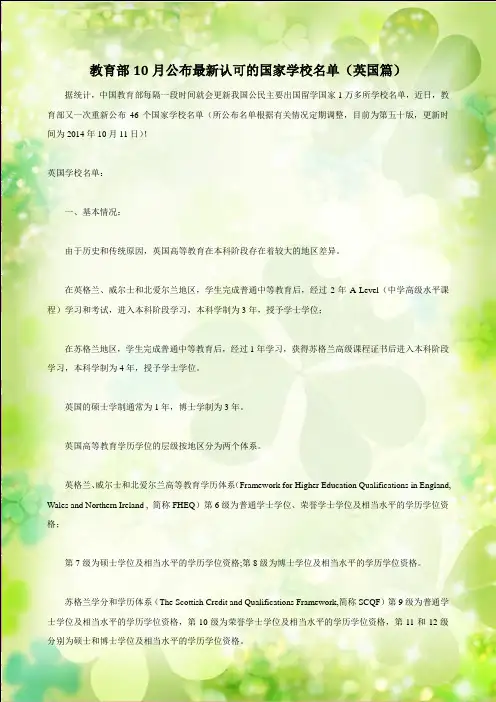
教育部10月公布最新认可的国家学校名单(英国篇)据统计,中国教育部每隔一段时间就会更新我国公民主要出国留学国家1万多所学校名单,近日,教育部又一次重新公布46个国家学校名单(所公布名单根据有关情况定期调整,目前为第五十版,更新时间为2014年10月11日)!英国学校名单:一、基本情况:由于历史和传统原因,英国高等教育在本科阶段存在着较大的地区差异。
在英格兰、威尔士和北爱尔兰地区,学生完成普通中等教育后,经过2年A-Level(中学高级水平课程)学习和考试,进入本科阶段学习,本科学制为3年,授予学士学位;在苏格兰地区,学生完成普通中等教育后,经过1年学习,获得苏格兰高级课程证书后进入本科阶段学习,本科学制为4年,授予学士学位。
英国的硕士学制通常为1年,博士学制为3年。
英国高等教育学历学位的层级按地区分为两个体系。
英格兰、威尔士和北爱尔兰高等教育学历体系(Framework for Higher Education Qualifications in England, Wales and Northern Ireland , 简称FHEQ)第6级为普通学士学位、荣誉学士学位及相当水平的学历学位资格;第7级为硕士学位及相当水平的学历学位资格;第8级为博士学位及相当水平的学历学位资格。
苏格兰学分和学历体系(The Scottish Credit and Qualifications Framework,简称SCQF)第9级为普通学士学位及相当水平的学历学位资格,第10级为荣誉学士学位及相当水平的学历学位资格,第11和12级英国高等教育机构依据皇家特许或法规设立并自主办学。
英国高等教育机构的学位授予权,须经皇家特许、议会法案或者枢密院予以批准。
目前有150余所院校获准授予各种不同类型的学位。
英国高等教育质量保障署(QAA)成立于1997年,是英国负责监督高等教育质量标准的机构,它负责对申请学位授予权的高校进行审查,并向商业、创新和技能部(BIS)提出建议。
中国教育部认证英国⼤学清单 随着店铺热潮的迅速膨胀,也催⽣了许多所谓的“野鸡⼤学”,尤其是英国、美国等热门留学国家,许多第⼀次店铺的学⽣和家长⽆法分辨,不⼩⼼选择了野鸡⼤学,既浪费了时间也浪费了⾦钱。
国外院校学历是否受中国教育部认可,这是店铺是否有价值的根本体现。
下⾯就跟店铺⼀起来看看教育部认证的英国⼤学名单,⼤家可以登录中国教育部涉外监管⽹了解更多详情。
按字母顺序排列 A 阿伯丁⼤学University of Aberdeen 阿伯泰邓迪⼤学University of Abertay Dundee 安格利亚理⼯⼤学Anglia Polytechnic University 阿斯顿⼤学Aston University B 巴斯⼤学University of Bath 伯明翰⼤学University of Birmingham 波恩茅斯⼤学Bournemouth University 布拉德福德⼤学University of Bradford 布莱顿⼤学University of Brighton 布⾥斯托⼤学University of Bristol 布鲁内尔⼤学Brunel University ⽩⾦汉⼤学University of Buckingham C 剑桥⼤学University of Cambridge 卡地夫⼤学Cardiff University 伯明翰英格兰中部⼤学University of Central England (UCE) in Birmingham 兰开夏中部⼤学University of Central Lancashire 城市⼤学City University 考⽂垂⼤学Coventry University D 德蒙特福⼤学De Montfort University 德⽐⼤学University of Derby 邓迪⼤学University of Dundee 达勒姆⼤学University of Durham E 东安格利亚⼤学University of East Anglia (UEA) 东伦敦⼤学University of East London 爱丁堡⼤学University of Edinburgh 埃塞克斯⼤学University of Essex 埃克斯特⼤学University of Exeter G 格拉摩根⼤学University of Glamorgan 格拉斯哥⼤学University of Glasgow 格拉斯哥卡利多尼亚⼤学Glasgow Caledonian University 格楼西斯特郡⼤学University of Gloucestershire 格林威治⼤学University of Greenwich H 海⾥特-⽡特⼤学Heriot-WattUniversity 赫特福德郡⼤学University of Hertfordshire 哈德斯菲尔德⼤学University of Huddersfield 赫尔⼤学University of Hull K 基尔⼤学Keele University 坎特伯雷肯特⼤学University of Kent at Canterbury ⾦斯顿⼤学Kingston University L 兰卡斯特⼤学Lancaster University 利兹⼤学University of Leeds 利兹城市⼤学Leeds Metropolitan University 莱切斯特⼤学Leicester University 林肯⼤学University of Lincoln (原名University of Lincolnshire & Humberside) 利物浦⼤学University of Liverpool 利物浦约翰摩尔斯⼤学Liverpool John Moores University 伦敦⼤学⼽尔德斯密斯学院Goldsmiths College, University of London(UL) 伦敦⼤学帝国理⼯学院Imperial Collegeof Science, Technology & Medicine, UL 伦敦⼤学国王学院King's College London, UL 伦敦⼤学伦敦政治经济学院London School of Economics & Politics Science(LSE), UL 伦敦⼤学玛利⼥王和韦斯特菲尔德学院Queen Mary and Westfield College, UL 伦敦⼤学皇家霍洛威学院Royal Holloway, UL 伦敦⼤学亚⾮研究学院School of Oriental and African Studies(SOAS), UL 伦敦⼤学学院University College of London(UCL), UL 伦敦市政厅⼤学London Guildhall University 拉夫堡⼤学Loughborough University 卢顿⼤学University of Luton M 曼切斯特⼤学The University of Manchester 曼切斯特理⼯⼤学University of Manchaster Institute of Science & Technology(UMIST) 曼切斯特城市⼤学Manchester Metropolitan University ⽶德尔赛克斯⼤学Middlesex University N 纳⽪尔⼤学Napier University, Edinburgh 纽卡斯尔⼤学University of Newcastle upon Tyne 纽卡斯尔诺⽣⽐亚⼤学University of Northumbria at Newcastle 北伦敦⼤学University of North London 诺丁汉⼤学University of Nottingham 诺丁汉特伦特⼤学Nottingham Trent University O ⽜津⼤学University of Oxford ⽜津布鲁克斯⼤学Oxford Brookes University P 佩斯利⼤学University of Paisley 浦利茅斯⼤学University of Plymouth 朴次茅斯⼤学University of Portsmouth Q 贝尔法斯特⼥王⼤学Queen's University of Belfast R 雷丁⼤学University of Reading 罗伯特哥敦⼤学Robert Gordon University S 萨尔福德⼤学University of Salford 谢菲尔德⼤学University of Sheffield 谢费尔德哈莱姆⼤学Sheffield Hallam University 南安普敦⼤学University of Southampton 南岸⼤学South Bank University 圣安佐斯⼤学University of St Andrews 斯坦福德郡⼤学Staffordshire University 斯德灵⼤学University of Stirling 斯特拉斯克莱德⼤学University of Strathclyde 桑德兰⼤学University of Sunderland 萨⾥⼤学University of Surrey 萨⾥⼤学, 鲁尔汉普敦University of Surrey, Roehampton 萨塞克斯⼤学University of Sussex T 提赛德⼤学University of Teesside 泰晤⼠河⾕⼤学Thames Valley University U 阿尔斯特⼤学University of Ulster W 威尔⼠⼤学阿伯⾥斯特威斯分校University of Wales, Aberystwyth 威尔⼠⼤学班⼽分校University of Wales, Bangor 威尔⼠⼤学卡地夫学院University of Wales, Cardiff Institute 威尔⼠⼤学纽波特学院University of Wales College, Newport 威尔⼠⼤学兰彼得分校University of Wales, Lampeter 威尔⼠⼤学斯旺西分校University of Wales, Swansea 华威⼤学University of Warwick 威斯敏斯特⼤学University of Westminster 英格兰西部⼤学,布⾥斯托University of the West of England, Bristol 沃尔沃汉普敦⼤学University of Wolverhampton Y 约克⼤学University of York。
英国前100所大学排名名单1 牛津大学Oxford2 剑桥大学Cambridge3 帝国理工学院Imperial College4 伦敦经济政治学院London School of Economics5 华威大学Warwick5 爱丁堡大学Edinburgh6 伦敦大学学院University College London7 圣安德鲁斯大学St Andrews9 约克大学York10 杜伦大学Durham10 布里斯托大学Bristol12 诺丁汉大学Nottingham13 巴斯大学Bath14 拉夫堡大学Loughborough15 伦敦大学亚非研究学院SOAS16 伦敦大学皇家霍洛威学院Royal Holloway16 伦敦大学国王学院King's College London16 曼切斯特大学Manchester19 纽卡斯尔大学Newcastle20 格拉斯哥大学Glasgow21 谢菲尔德大学Sheffield22 卡迪夫大学Cardiff23 伯明翰大学Birmingham24 莱斯特大学Leicester25 邓迪大学Dundee26 阿斯顿大学Aston26 南安普敦大学Southampton28 阿伯丁大学Aberdeen29 艾塞克斯大学Essex30 兰卡斯特大学Lancaster31 贝尔法斯特女王大学Queens, Belfast32 斯特拉思克莱德大学Strathclyde33 东英吉利大学East Anglia34 艾克斯特大学Exeter35 基尔大学Keele36 赫瑞-瓦特大学Heriot-Watt37 萨塞克斯大学Sussex38 利兹大学Leeds39 瑞丁大学Reading40 斯德灵大学Stirling41 利物浦大学Liverpool42 斯旺西大学Swansea43 布鲁内尔大学Brunel44 伦敦大学玛利皇后学院Queen Mary45 萨里大学Surrey46 坎特伯雷肯特大学Kent47 布拉德福德大学Bradford47 赫尔大学Hull49 诺桑比亚大学Northumbria50 阿伯瑞斯特威斯大学Aberystwyth51 威尔士大学卡迪夫学院UWIC, Cardiff52 威尔士大学兰彼得学院Lampeter53 牛津布鲁克斯大学Oxford Brookes54 伦敦大学金史密斯学院Goldsmiths College55 阿尔斯特大学Ulster55 城市大学City57 普利茅斯大学Plymouth58 班戈大学Bangor58 罗伯特高登大学Robert Gordon60 赫特福德郡大学Hertfordshire61 金斯顿大学Kingston62 诺丁汉特伦特大学Nottingham Trent62 桑德兰大学Sunderland64 西英格兰大学West of England65 伦敦艺术大学University of the Arts66 布莱顿大学Brighton67 菲尔德哈莱姆大学Sheffield Hallam68 萨尔福德大学Salford69 西敏寺大学Westminster70 萨里大学,鲁尔汉普顿Surrey Roehampton71 格拉摩根大学Glamorgan72 哈德斯菲尔德大学Huddersfield73 阿伯泰邓迪大学Abertay Dundee74 格拉斯哥卡利多尼亚大学Glasgow Caledonian75 曼切斯特城市大学Manchester Metropolitan76 佩斯利大学Paisley77 朴次茅斯大学Portsmouth78 英格兰中部大学Central England79 米都塞克斯大学Middlesex80 林肯大学Lincoln80 斯坦福郡大学Staffordshire82 纳皮尔大学Napier83 利物浦约翰摩尔斯大学Liverpool John Moores84 伍尔弗汉普敦大学Wolverhampton85 伯恩茅斯大学Bournemouth86 兰开夏郡中部大学Central Lancashire87 格洛斯特郡大学Gloucestershire88 考文垂大学Coventry89 德蒙福特大学De Montfort90 利兹城市大学Leeds Metropolitan91 卢顿大学Luton91 梯塞德大学Teesside93 威尔士大学新港学院UWCN, Newport94 英吉利理工大学Anglia95 南岸大学London South Bank96 德比大学Derby97 格林尼治大学Greenwich99 东伦敦大学East London100 泰晤士河谷大学Thames Valley。
任务型阅读(九)事物介绍+现代科技A [2024·原创]You may think you cannot live through summer without air conditioners. But in ancient China, hand fans were almost the only ones to help people keep cool. There are many types of hand fans with different uses.Chinese people started to use hand fans over 2,000 years ago. The fans came in different shapes, such as round and square. They were also made from all kinds of materials. Palm leaf fans were cheap and easy to make. Feather fans(羽毛扇) showed the owner's high status. Sandalwood(檀香) fans could send out a sweet smell.Later, hand fans became far more than just something that could cool you down. They developed into artworks, in which tuanshan(round fans) and zheshan(folded fans) were the most common.In the shape of a full moon, tuanshan were usually made of silk. They had beautiful birds and flowers on them. Women, especially those in the imperial palace(皇宫), liked to use them. Meanwhile, men, especially the literati(文人学士), used zheshan. The literati liked them because zheshan were usually made of paper and they could paint and write poems on them. It was a way for them to show off their ability in literature, painting and handwriting. Almost anything can be painted on zheshan.Today, Chinese people still use these fans, only not many people write or paint on them any more. When you are waving a fan, you may think of the stories behind it.1、2题完成句子;3题简略回答问题;4题找出并写下全文的主题句;5题将文中画线句子译成汉语。
英国将关闭190所野鸡大学附最新教育部认证的英国大学名单近日,英国政府宣布,将立即关闭190家提供虚假学位的英国“野鸡大学”。
在这些学校中,有些通过仿冒现有院校,如校名比正规大学少了字母或者校名与正规大学换词序,有些则以英国著名地点来命名。
据英国《独立报》报道,英国多家机构近日联合重拳打击在英国的“野鸡大学”,此次行动由英国商业、创新和技能部授权,由高等教育学位检验机构(HEDD)和英国毕业生职业服务机构“前景”共同操作。
下面,点课台君将带大家一起来了解部分假冒大学的名单,并详细解读如何辨别大学的真伪。
越来越多的人选择出国留学,但留学人员不得不提防“野鸡大学”。
一旦迈入这类学校,不光损失大量金钱,更有可能浪费求学时间。
“野鸡大学”(diplomamill,直译为“文凭磨坊”)所授予的“学位”和“文凭”,不仅不受中国教育部的认可,在全球范围内也是不受认可的。
部分英国“野鸡大学”名单University of WolverhamtonManchester UniversityAAAardvark UniversityNational Distance Learning CollegeThe Cambridge College of LearningBristol International CollegeWarnswick UniversityChelsea UniversityGlasgow Caledonian UniversityDe Montfort UniversityGrantchester UniversityMount Carmel UniversityJohn Hever AcademyEastville UniversityBerkshire UniversityOur Lady of the Britney Spears UniversityLondon Academy of Management Science(LAMS)假冒大学爱搞“面子工程”不少中国学生受影响他们的宣传网站上有漂亮的教学楼、图书馆、舒适整洁的宿舍,但这些往往都是盗取其他学校或者组织的公共设施而获得的。
英国主要城市介绍伦敦London→伦敦位于英格兰东南部,跨泰晤士河下游两岸,人口717万。
伦敦是英国的首都,最大海港和首要的工业城市,也是全国政治、经济、文化与交通的中心,还是世界金融中心之一,世界十大都市之一。
伦敦交通发达,古迹繁多,有“英国旅游中心”之称。
伦敦以它悠久的历史、斑斓的色彩、雄伟的风姿屹立于世界名城之林。
位于伦敦的大学有:LSE,Imperial College,UCL,KCL,SOAS,Middlesex University,University of East London,London Metropolitan University,Royal Holloway University of London,Greenwich University曼彻斯特Manchester→位于英国西北部,是英国第三大城市,人口250万。
乘坐火车去伦敦和伯明翰分别只要3个小时和一个半小时,去爱丁堡也只要3个半小时。
曼彻斯特拥有全英第二大的中国城,中国城内遍布饭店和超市。
每逢元霄节等重大节日,在这里都会举行盛大的庆祝活动。
此地最为引人瞩目的当属英超豪门曼联了,周末您可以就近观看曼联的比赛。
位于曼彻斯特的大学有:University of Manchester,University of Salford.伯明翰Birmingham→位于英格兰中部平原,是英国第二大城市,距伦敦仅160千米,人口224万。
市区分为新城和老城,新城火车站附近是英国工业展览会的所在地,老城车站是伯明翰的市中心,这里商店集中,道路狭窄,人流不息,因而禁止车辆通行。
伯明翰市区只有少数的高楼大厦,大部建筑都是维多利亚式的二层楼房,古朴典雅。
伯明翰是现代冶金和机器制造工业的创始地,同时也是全国主要铁路、公路干线和运河网的交汇点,交通十分便利。
伯明翰远郊工厂林立,其工业产值占全国的1/5。
城市本身是英国近年来发展迅速的文化中心,其交响乐团及爵士乐队都在国际上享有盛名。
Authoring Educational Hypermedia Using a Semantic NetworkD.J. Mullier, M.B. DixonFaculty of Information and Engineering SystemsLeeds Metropolitan UniversityEngland[d.mullier][m.dixon]@Abstract: Authoring hypermedia is a difficult process and any deficiencies in theauthoring process are likely to be reflected in the student’s educational experience.This paper is concerned with providing the author with a framework and process soas to reduce the possibility of producing a poorly structured domain. The discussionis centred on practical experiences with an educational hypermedia system producedat Leeds Metropolitan University that helps the author to structure the domain by theuse of a semantic network which is used to represent the essential structure of thedomain. Since it is an educational system tutorial nodes are used within thehypermedia to provide the student with tasks to reinforce their learning. The locationand use of these tutorial nodes is discussed, in that they may be used as landmarks tohelp orientate a student.IntroductionIt has been argued by Pereira et al (1991) that all hypermedia systems should have a semantic network (or similar structure) defined within them to aid both the author and the end user. Jonassen and Wang (1993) have further suggested that structures such as semantic networks provide the student with structural information that aids them in the retention of hypermedia material. Further studies have shown that complex information and arguments can be represented in semantic network-like web like structures, termed mind-maps or concept maps and that the use of such structures can aid the author of the structure to remember the information stored within them (McAleese 1998, Holmes 1999). Given this, this paper discusses the implications and the process of defining a semantic network.In order to explore the issue of authoring an educational hypermedia domain, and other issues described in Mullier et al (1998) and Mullier (1999), a prototype educational hypermedia system, called “Hypernet”, has been developed at Leeds Metropolitan University. The remainder of the discussion uses Hypernet as an example of an educational hypermedia system, but the discussion is not restricted to Hypernet itself.Domain TypesThe exemplar domain designed for the conception and implementation of Hypernet was an astronomy domain. This domain was chosen for the reason that it is highly structured and hierarchical, making it ideal for application to this system, since it allows the rapid design of a semantic network. However, the goal of the project as a whole is to devise a paradigm that is as generic in approach as possible, so that it can be applicable to a multitude of domains. In practice, however, it is likely to be the case that some domains are easier to describe as a semantic structure than others. This is because some domains do not exhibit an obvious and generally accepted structure. This could result in a new hypermedia problem similar to “Linkitis” (Conklin 1987), in that if an author is unsure how a domain may be structured then they may be tempted to force a structure on the domain that may not necessarily exist or be helpful. This may result in the student becoming confused and hence render the domain difficult to navigate, exacerbating the lost in hyperspace problem. It is not an ideal situation, however, to allow the students to identify the shortcomings of a domain’s design. It is suggested, therefore, that it is the author’s responsibility to ensure that the domain is designed correctly before it is exposed to students. It is accepted that this is not a trivial task however.The authoring process is a complex one and has often been overlooked by hypermedia designers (Theng and Thimbleby 1998, Conklin 1987). It is, however, fundamental to the student’s learning needs that the domain is authored to a sufficient standard (Jonassen and Wang 1993). This is especiallytrue for “fixed-link” systems (systems that do not provide dynamic links). In fixed-link systems it is vital that the author provides the correct links for every possible user of that hypermedia system. Bell (1995) argues that people are not good at writing in a non-linear fashion, therefore hypertext (hypermedia) documents tend to become linear and do not model the true (semantic) structure of the domain itself. By producing hypermedia systems that require a semantic network forces the domain author to consider the structure of the domain and hence is far more likely to result in a domain that provides an adequate structure for the student to navigate. Further, if dynamic links are employed the student is provided with links that more closely meet their requirements and so reduces their cognitive loading.Defining A DomainHere Hypernet is used as an example hypermedia tutoring system. The process of defining a domain for use in Hypernet involves the following steps:• Structuring the domain into a semantic network (defining its structure) by providing typed links between class nodes (class nodes may also be used as hypermedia nodes).• Forming a semantic hypermedia domain by attaching instance nodes to the class nodes (instance nodes may be used as hypermedia nodes).• Storing suitable exercises within tutorial nodes, which are connected to the semantic hypermedia.For a standard hypermedia system it would usually be the case that none of the above stages would be employed, since the majority of hypermedia systems remain unstructured (Dillon and Gabbard 1998). Instead, the author determines for every node in the domain how it connects to all of the other nodes, typically an extremely complex task. However, the application of the semantic network encourages the domain author to organise the domain in a more logical fashion. The final stage is unique to a computer based learning system, as opposed to a general browsing hypermedia system. Since it is difficult for a student to learn in an undirected environment (Jonassen and Wang 1993) it is appropriate for the domain author to require the student to accomplish some task, at least until they have become proficient enough in the domain to be allowed to browse freely.Figure 1 An Example DomainThe Semantic NetworkA semantic network can be defined as a graphical representation relating concepts and information et al Beynon-Davies 1994). A concept in a semantic network is defined as a node and labelled arcs (links) define the relationships between concepts. The example semantic network, shown in figure 1, describes part of a simple astronomical solar system domain. The oval nodes represent class nodes and form theoverall structure of the domain. The square nodes represent the instance nodes that are subsequently attached to the class nodes. Each class node is therefore used as an anchoring point for instance nodes. Therefore every instance node in the hypermedia is connected directly to the class structure of the semantic network. For example, the instance node “Earth” is attached to the class node “Planet”, thus all “Planets” are logically collected around the “Planet” class node. Each instance and class node is visible to the student as a hypermedia node. It is therefore of potential use to the student and author to utilise the class nodes for presenting higher-level information that relates to the nodes connected to it. For example, the instance nodes “Earth”, “Mars” and “Jupiter” are attached to the class node “Planet”. The instance nodes contain information that relates purely to the node itself (the “Earth” node contains information about the Earth). The class node “Planet” may therefore hold information, useful to the student, about the higher level “Planet” node (which may not have been present without the need for the semantic network) and may provide information as to why each node attached to it, should be attached to it. In many hypermedia systems the only way to discover this fact is to traverse a link that exists between the two and rely upon the domain author providing the information within both nodes that each is a volcano. If the student is forced to undergo this procedure in order to discover the relationship between two nodes then they are further exposed to the “risks” of navigation in a complex information structure. The semantic network however reduces the danger of the cognitive loading problem and navigation problem associated with the hypermedia paradigm, by providing a student with contextual information and by forcing the author to structure the domain more logically (Pereira et al 1991, Jonassen and Wang 1993).Link TypesThis standardised set of link types, described fully in (Beynon-Davies et al 1994) are defined below as: ISA – relates an object to a class, i.e. it defines an instance of a class. For example “Mars” ISA “Planet”, “Mars” being the instance of the class “Planet”. This link is unidirectional in that properties are inherited in one direction only. For example the “Mars” node inherits all properties from the “Planet” node by virtue of this link (such properties or attributes may include the fact that a Planet orbits the Sun, thus Mars orbits the Sun). However “Planet” does not inherit properties from “Mars”. The IS-A relationship usually represents information towards the top of a hierarchy and therefore represents more general information (Tudhope and Taylor 1997).AKO (a-kind-of) – relates a class to another class, or may define a subset. This link type demonstrates the relationship between classes. This type is fundamental in connecting a class nodes together to form one semantic network. For example “Planet” AKO “Solar System Body”, meaning that a “Planet” is a kind of “Solar System Body” and that a “Planet” inherits all properties of the class “Solar System Body”. Tudhope and Taylor (1997) have referred to the AKO link as “narrower-than”, since it represents information at the bottom of a hierarchy, which is usually more detailed or narrower in scope.PARTOF (part-of) – represents how an object is composed of other objects, or inherits only part of the parent class. This link type demonstrates how a class may be associated with component parts. For example, “Geographical Feature” PARTOF "Planet". The part-of link implies that there is a relationship between instances of classes connected via a part-of link.HASA (has-a) – relates an object to a property or attribute. This is not used to represent structural information (it is not used as a link type). Instead it may be used to represent knowledge within a class. For example, a “Planet has-a Diameter”. This may be used to ensure that an object conforms to a class exactly (i.e. the author is aided in deciding if a node belongs to a particular class by virtue of it having the same attributes). As noted by Beynon-Davies et al (1994), this link type also aids queries in that a search may search for exact matches, such as “Planets with diameters greater than 100”.The above link types allow the structure of a domain to be represented. However, further link types may be required to represent course material. For example, it may be necessary to represent dependencies, if one concept must be learned before another, or to represent counter arguments. Extra link types such as "dependent-on" could be used by hypermedia systems to determine whether a node is relevant to a particular student. If a student has not visited the node at one end of the link then the node at the other end is not relevant and may be hidden or greyed out in accordance with the hiding method discussed in Brusilovsky (1996). The "dependent-on" link can therefore be used to represent course information, where it is common to lead a student through topics that are dependent upon each other.Further link types may include "example-of", "counter-example-of", “supported-by” and “disputed-by”. Link types such as these provide a greater depth of information about a particular node. Therefore it may be necessary to separate a node into several nodes representing various levels of detail. It is arguable that some node types such as "counter-example-of" may not be beneficial to lower-level students, since they may contain contradictory or otherwise confusing information, therefore there may be a case to make such links available to only the higher level students. Further, in the area of concept mapping, which can be said to share some common attributes with hypermedia, there can be any number of author (of the concept map) definable link-types (McAleese 1998). In essence it does not matter whether the domain author uses a predefined set of link types or whether they use their own. Other researchers have attempted to produce automatic links differently, depending upon the link types that connect two remote nodes. Tudhope and Taylor (1997) calculate automatic links by giving a stronger relationship between nodes connected by AKO relationships than IS-A relationships. The reason for this is that relationships at the bottom of hierarchies, represented by AKO relationships, are thought to be more closely related than those at the top, represented by IS-A relationships (Tudhope and Taylor 1997). The use of different strengths of relationships has not been explored as part of this research project, although it may prove to be beneficial as part of further work. Further, it may be possible to combine the information potentially available from the student’s browsing pattern to dynamically alter the strength of the link types, in that if a user is determined, by virtue of their browsing pattern, to be interested in general information then the strength of the IS-A link type could be increased and vice versa.Adding Nodes to the DomainOnce a semantic network has been defined for the domain in terms of class nodes, then instance nodes may be added to it. The author must decide to which class a new node belongs, a class being represented by a class node (connected to other class nodes via ISA and/or AKO link types). If there is no such class node, then the semantic network has not been sufficiently defined for the domain or the new node does not belong to the domain. This is an important restriction, since there may be more than one author for the domain. It is possible that a domain may be initially defined by an author, but extra nodes are added to it subsequently, perhaps after students have begun using the hypermedia. The addition of the semantic network is an aid to all such authors, since it has the potential to help them to decide if a node should belong to the domain. An author who is unsure as to the legitimacy of a node’s relationship with the domain, may succumb to the “Linkitis” problem, i.e. if unsure then link. The semantic structure aids such an author by providing them with a structure into which the node must fit. It is possible that the responsibility for deciding whether a node should be added to the domain lies with the original semantic network author, since it could be stated that if a node cannot be typed to an existing semantic network node, then it should not belong to the domain. This could be achieved by allowing only certain classes of author to modify or otherwise add to the semantic network. Thus, the integrity of the domain is protected to a far higher degree than would be the case with a hypermedia system without a semantic network.Once a node has been correctly typed, it is connected to the semantic network. This immediately connects the new node to all the other nodes in the hypermedia system, via paths of varying lengths, thus the author need not specify any other direct links. It is likely however, that an author wishes to add a series of related nodes. For example, the author may wish to add the node "Pluto" to the domain. This could involve the addition of several new nodes, namely the node “Pluto” representing the planet itself and “Charon”, representing Pluto’s only satellite. The author therefore types “Pluto” is-a “Planet” and “Charon” is-a “Satellite”. Once “Charon” has been correctly typed, the author is required to connect it to a host “Planet”, since this is an explicit requirement of the “Satellite” type (a reasonable requirement since satellites do not exist in isolation). The original author of the semantic network encodes this requirement within the semantic node itself.The semantic network is therefore a structure that connects the entire domain together. It is vital that the author connects the class nodes together in an accurate fashion. As discussed above, it may not be clear cut decision whether to connect a node to a particular class node or not. The author may have to make a decision about connecting two class nodes together when the relationship between them is not a definite one. The author should detail this relationship within the class node so that any future author is clear about the defined relationship. It may not always be the case that such a one to one relationship can be defined, i.e. an instance node may not fit exactly into the semantic structure of the domain, but may still be valuable to the student studying the domain. In this situation the author should provide a suitable “non specific” semantic node. For example, the domain author may wish to add informationabout probe missions to various planets. The author may decide that it is not appropriate to add the semantic node “Probe Missions” as a-kind-of “Planet”. However, it may be appropriate to have information about the Voyager missions to Jupiter, with the "Jupiter" instance node. The author could therefore define the semantic node “Related Material” as part-of “Planet”. It is important that this facility is used sparingly, otherwise the benefits of structuring the domain could be lost.Defining Tutorial NodesTutorial nodes are employed by Hypernet as a means to aid the student’s retention of the domain contents. Jonassen and Wang (1993) suggest that information is retained by providing a context into which the information fits, thus aiding the student in determining where the information fits within their own knowledge representation structures (schema). In Hypernet this is aided by providing the students with tasks to complete, via the tutorial nodes. Tutorial nodes may take the form of a simple question and answer session, or they may involve a more complex task that requires that the student to visit several nodes. Such tasks may require the student to traverse the hypermedia looking for various pieces of information. Requiring the student to find and examine the relationship between concepts may also aid their retention of structural knowledge of the domain (Jonassen and Wang 1993). It is therefore paramount that tutorial nodes are designed and placed within the hypermedia in order to render this transfer of knowledge as efficient as possible.The tutorial nodes are designed to remove the danger of passivity from the system, i.e. the student is not always left to wander through a hypermedia system, without a task or guidance, especially if they are a novice of the domain. It could be argued that a human teacher could present the student with a learning task before they are exposed to the hypermedia system. However, this would require the human teacher to supply the student with a complete task that would detail requirements for the student, as they become more proficient with the domain. Alternatively, it would require that the human teacher is constantly present, in order to gauge when the student requires a new more advanced task. The latter situation is not always possible, since the human teacher is an expensive resource and the need for ITSs has been driven by this fact (Woods and Warren 1995). The former situation is also not desirable, since providing the novice student with expert level tasks (for their future use), may be providing the student with a level of complexity that is not beneficial to them (Ridgeway 1989, Kinshuk and Patel 1997).Tutorial Nodes are embedded within the hypermedia, although they do not strictly form part of the semantic network, in that they do not represent the structure of the domain. A tutorial node may be triggered by a simple rule, defined by the domain author. For example: “Activate Tutorial Node 1 when the student enters the system”. The student is therefore given a task to complete as soon as they enter the system. It is advised that such a task should concentrate on providing the student with information about how to use the hypermedia tutoring system itself and not necessarily be related to the domain, since initially, a user who is new to a system expends most of their “cognitive power” learning how to use a new system .Linear and Non-Linear Tutorial NodesTutorial nodes may exist in “linear hyperspace” and “non-linear hyperspace”. They may be designed to be encountered one after the other, guiding the student through the hypermedia (linear hyperspace). Alternatively, they may be activated by a student following their own interests into a particular area of the hypermedia (non-linear hyperspace). Linear hyperspace is similar to Trigg’s (1988) idea of paths authored into a hypermedia system. Trigg’s system, "TexNet", allows the author to specify default paths for the student to follow, in order to reduce the chances of them becoming lost. Such a method has been criticised by Jonassen and Wang (1993), for providing the student with a path that they may “blindly” follow, i.e. they are encouraged not to search the hyperspace. The same criticism cannot however be levelled at the linear hyperspace tutorial nodes (LTN) employed by Hypernet, since they are not providing a node to node path. Instead the LTNs are providing the student with useful landmarks with which to orientate themselves, in that the student can navigate from one LTN to the next. They may therefore travel through the hypermedia in freedom, between such tutorial nodes. These nodes are suitable for novice students, since they are guided (as opposed to forcefully directed) by the tutorial nodes.The non-linear hyperspace tutorial nodes are intended for more advanced students, since they do not provide the guidance that the LTNs provide. This is because the NLTNs do not appear in a predefinedsequence. Instead, it is a matter of when the student uncovers them. They therefore do not offer the same landmark qualities as their linear counterparts. Such nodes are therefore more suited to students of higher levels, since the student may randomly encounter them and are not lead from one to the next. The LTNs may be useful for lower level students and the NLTNs for higher level students. It may be desirable in some instances to use the two types of tutorial nodes interchangeably; for example, using LTNs for an expert level student who has entered an unvisited section of the domain. It may also be desirable for the author to target certain tutorial nodes at certain levels of students, or to have slightly different tutorials, for each student level, present within the same tutorial node. Figure 9.3.1.A (shown previously) shows two NLTNs, labelled "Planet Tutorial" and "Volcano Tutorial". These nodes are invoked when the node to which they are connected to via an "Invoked-by" link is selected. For example, the "Volcano Tutorial" is invoked when the "Volcano" class node is visited. ConclusionExperiences with Hypernet suggest that the use of a semantic network does indeed help the author to represent their knowledge in a formalised way, suitable for expression as a hypermedia domain. Whether this domain representation is more of less useful to the student is open to educational debate, however, the literature concerning the use of semantic networks would strongly indicate that it is (Tudhope and Taylor 1997, Pereira et al 1991, Jonassen and Wang (1993).ReferencesBell G, 1995, Knowledge Modelling and Adaptive Hypertext. In Proceedings of the University of Nottingham Psychology Department, Post Graduate Conference, 1995. Available from /~grb/papersBeynon-Davies P, Tudhope D, Taylor D, Jones C, 1994, A Semantic Approach to Knowledge-Based Hypermedia Systems. In Information and Software Technology, 36(6), pp 323-329Brusilovsky P 1996, Adaptive Hypermedia: an Attempt to Analyze and Generalize. In Multimedia, Hypermedia and Virtual Reality, Lecture Notes in Computer Science, Vol 1077, pp 288-304, Springer-Verlag.Conklin J 1987, Hypertext: An Introduction and Survey. In IEEE Computer, September 1987, pp 17-41.Dillon A, 1990 Designing the human computer interface to hypermedia applications. In Hypermedia for Learning, D.Jonassen (ed), pp 57-65. Springer-Verlag.Holmes B, 1999, Beyond Words, In The New Scientist, No.2194, July 10, 1999, pp 32-37, Reed Business Information.Jonassen D H, Wang S, 1993, Acquiring Structural Knowledge from Semantically Structured Hypertext. In Journal of Computer-Based Instruction; Vol 20 No. 1 pp 1-8, 1993.Kinshuk, Patel A, 1997, A Conceptual Framework for Internet based Intelligent Tutoring Systems. In Knowledge Transfer (Volume II), pp 117-124, Behrooz A (ed); Pace, London.McAleese R, 1998 The Knowledge Arena as an Extension to the Concept Map: Reflection in Action; In Interactive Learning Environments, Vol. 6, No. x. (Available from /~ray. Mullier D J, Hobbs D J, Moore D J, A Hybrid Semantic/Connectionist Approach to Adaptivity in Educational Hypermedia Systems. In Proceedings of ED-MEDIA’99, Seattle, WA. 1999Mullier D J, 1999, The Application of Neural Network and Fuzzy-Logic Techniques to Educational Hypermedia. PhD thesis. Available from /ies/comp/staff/dmullier/thesis/thesis.htmlPereira D C, de Oliveira A, Vaz J C G, 1991, Hypermedia and ITS. In Intelligent Systems in Education. Micarelli, Belastra (eds), pp 207-223.Theng Y, Thimbleby H, 1998, Addressing Design and Usability Issues in Hypertext and on the World Wide Web by Re-Examining the “Lost in Hyperspace” Problem. In Journal of Universal Computer Science, vol. 4, no. 11, pp 839-855.Trigg R, 1988, Guided Tours and Tabletops. In Tools for Communicating in a Hypertext Environment, ACM Trans. on Office Information Systems, Vol 6, No 4, Oct 1988, pp398-414.Tudhope D, Taylor C, 1997, Navigation via Similarity: Automatic Linking Based on Semantic Closeness. In Information Processing & Management, Vol. 33, No. 2, pp 233-247.Woods P, Warren J, 1995, Rapid Prototyping of an Intelligent Tutoring System, In Proceedings of the Australian Society for Computers in Learning in Tertiary Education Conference 1995 (ASCILITE’95).。